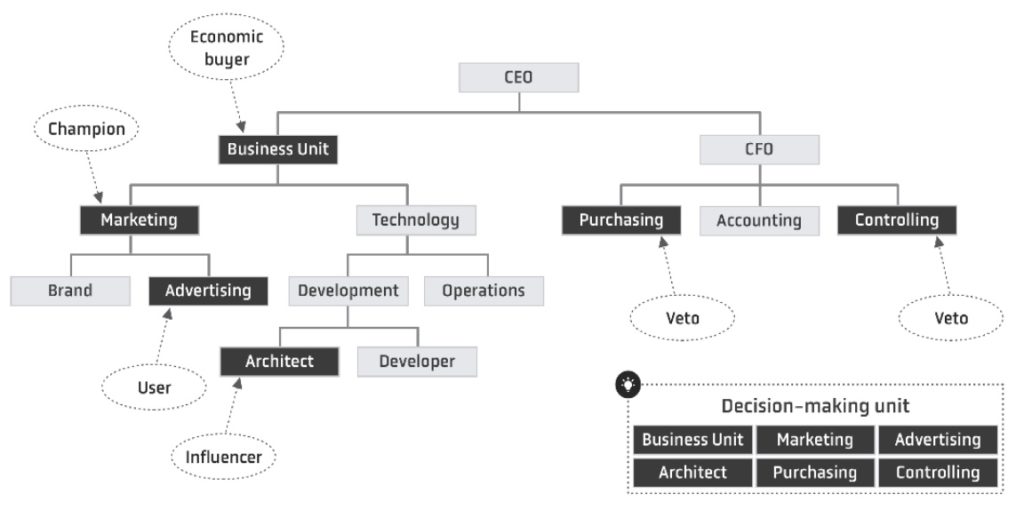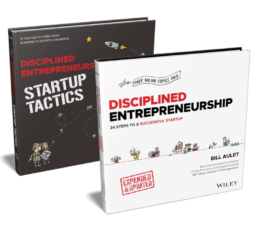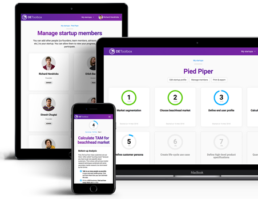The Disciplined Entrepreneurship Toolbox
Stay ahead by using the 24 steps together with your team, mentors, and investors.
Sign up for our newsletter
The challenge in B2B sales is that a company is not a single entity, like an actual human. It’s not the company that decides on buying your solution – it’s the humans within the company. And these humans can have conflicting interests and perspectives regarding your product.
In order to successfully sell to your target companies, you need to understand how the humans within the companies typically make purchasing decisions.
There are a lot of roles you may interact with during a typical B2B sales process. On an organization chart, your interactions during the process may look something like this:

Let’s look at those different roles in detail.
How to find the decision-making unit
In order to identify the relevant players in their specific context, Martin regularly refers the startups in his incubator to the “decision-making unit” framework by entrepreneurship professor Bill Aulet, the bestselling author of “Disciplined Entrepreneurship.”
The three primary roles in the decision-making unit
Bill Aulet advises founders to look for three primary roles in their target companies: End Users, Champions, and Primary Economic Buyers.
- The End User is the person who will actually use your product or service. The End User always plays a significant role in the buying decision.
- The Champion is the person who wants the customer to purchase your product. He may be the End User, but not necessarily so.
- The Primary Economic Buyer is the person in the company who can sign off on the money required to purchase your product.
To identify the decision-making unit, zoom in to your target segment. The basic assumption is that all three primary roles exist in one form or the other at every potential customer.
How to find out the decision-making units in the companies within your target segment
Ask questions. This is simple but powerful advice from Bill Aulet. Once you have a first person at your target company engaged, leverage the opportunity to ask them your questions:
- What would we need to do to bring our product in for a test?
- Who, besides you, needs to be involved in the decision?
- What could stop this from happening?
- Who controls the budget?
Be straightforward. Ogynan Vasilev from Salesforce encourages founders to not beat around the bush. If you’re not sure whether the person you have been talking to has the power to actually make a purchasing decision – just ask them. In most cases, they will give you a straightforward answer: “We need this one manager to be involved to decide.”
Champion and End User
The person you expect to be your Champion should be the first target to contact within a prospective customer.
Identifying your Champion’s typical role
Often your Champion will be an End User with a direct interest in the solution you are proposing:
It turned out that the person with the biggest pain was the easiest to approach. So we always tried to enter the organization bottom-up by finding a Champion for our solution.
It is good practice to describe Champions and other roles in a comprehensive “persona” – an illustrative description of the target person that describes his or her typical hierarchical position in the organization, their responsibilities, their targets, job titles, needs and fields of interest.
Creating personas will help you, and later your team, to search for and recognize the right kind of contacts within a larger organization.
Finding the right person in a specific company
Traditionally, calling the company headquarters and asking who might be the right person to talk to about your product was the #1 approach to get in touch (and it’s still a great idea).
Today, many employees especially in high-tech and digital industries are active on LinkedIn or similar professional networks. Whether you call or hunt on LinkedIn – be creative in your detective work:
For our first customer, it was important to understand their particular organizational structure. As a big corporation, they have unique roles and management levels. Some of the names at the top level were publicly known. We had also found a career website where they described their career levels, which we then compared to the job titles in the email signature to find out what level we were talking to. This is how we worked us in from the bottom up and from the top down at the same time.
While the Champions and End Users do not eventually make the actual purchasing decision, our experience shows time and again that the advocacy of these stakeholders can make a real difference in “winning the war,” especially if there are conflicting interests within the company.The strategic importance of Champions
In adding to the strategic component of identifying a Champion, Stephan Rohr of TWAICE further expands on the aspect of “emotional connection” to your Champion and highlights it as the crucial component of your sales effort:
Particularly in B2B, you need a champion who you’re having an emotional relationship with. He or she will have to overcome internal hurdles. And he or she wants to be able to sign your deal without having to worry that their head will be the first to roll because something went wrong. Especially when in the beginning, there won’t be any references with other big clients they can hide behind.
Ognyan Vasilev of Salesforce points out a typical pitfall for founders, especially in startups with highly technical solutions:Primary Economic Buyer
Startups often find it easy to connect with experts who understand their product and are excited about the tangible improvements it brings. However, these are often not the ones that will take the final decision on adopting the solution.
Keep in mind, too, that there are different levels of decision-making power within the same organization. Trying to sell a product of €100,000 to a department head who is not authorized to make this decision is a waste of time – and one of the most common mistakes founders make. For this reason, never focus solely on working with technical experts and R&D teams. After getting a foot into the door on the technical level, always try to get introduced to the economic decision-makers.
Identifying the typical Primary Economic Buyer role
If you are trying to find out who the Primary Economic Buyer of your product is, it helps to look at the organizational chart, as budget control is typically closely related to hierarchy. This will also help design the right marketing messaging for convincing the stakeholder at the relevant decision-making level.
Additional roles
While the primary roles are quite intuitive, it is important to understand additional roles that you may encounter. These are:
- Influencers – These are people who have the power to influence other decision-makers, based on their experience or standing within the company. They can reside either inside the company or outside; for example, in media publications, industry groups, or consultancies.
- Veto Powers – These stakeholders are particularly dangerous for you. In corporate settings, veto power can be based on hierarchy, but also on function. For example, the IT department may have veto power over any software or hardware purchase.
- Purchasing Department – Starting from a certain corporate size, you will encounter this department. It is focused on handling the entire purchasing process and famously aims to drive prices down. In general, think of them as a link in the chain that you should neutralize, but not actively sell to.
Keep the Big Picture in mind
A subconscious bias in the minds of many founders (and indeed many sales trainers) is the idea that you just need to know how to lead successful “sales conversations,” that is, how to talk to people to convince them to buy your product.
But as Robert B. Miller and Stephen E. Heiman already pointed out in their classic “Strategic Selling”: your strategy can only begin once you know who the players are.
Selling innovation to enterprise customers (business-to-business or B2B sales) is one of the toughest nuts for startup founders to crack. This text builds on the book Fast Forward: Accelerating B2B Sales for Startups. In their book, authors Matthias Hilpert, Investor, and Martin Giese, Business Angel and Startup Coach, share their insights from 40 years of operational experience and from interviews with 32 internationally successful founders from companies like Celonis, Northvolt, and Peakon. The accompanying teaching materials are available for free here on the Disciplined Entrepreneurship platform.
The authors
Martin Giese & Matthias Hilpert
Martin is a business angel, startup coach, negotiation expert, and author of the "Startup-Finanzierung" books. Matthias is one of the top 30 angels backed by EIF in Germany and has studied Business, Philosophy, and Artificial Intelligence.

The books
This methodology with 24 steps and 15 tactics was created at MIT to help you translate your technology or idea into innovative new products. The books were designed for first-time and repeat entrepreneurs so that they can build great ventures.

How relevant was this article to you?
Click on a star to rate it!
Average rating 4.9 / 5. Vote count: 20
No votes so far! Be the first to rate this post.
We are sorry that this article was not useful for you!
Let us improve this post!
Tell us how we can improve this post?
